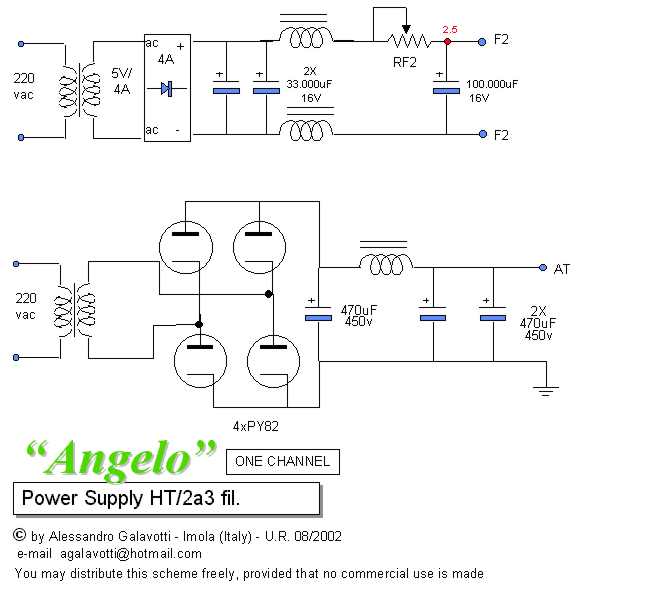
Angelo power supply
is build using a nice and interesting tube: PY82.
I happened
to have a bunch for very little money so I used it extensively in this
project.
Beside its price,
there's another nice thing about this tube: it's indirected heated
and so can be used to build Graetz bridges very easily.
This is quite interesting
feature: if you're ready to accept a little reduction in plate voltage,
you can substitute solid rectifiers without changing power supply
trasformers and experiment the sonic difference between SS and Vacuum tubes
rectifier.
You have to consider
that Voltage drop can be 20volts or more (depending on the current you're
dealing with), instead of the 0,7V of a SS diode so bias point can be noticeabliy
different.
you also have
to build a PS for the heater of PY82, but you are already guessing to try
this, this not a problem. ;)..
1)Try to guess how much your circuit needs.
Remeber that PY82 can bear currents not exceeding 150ma-180ma , but to keep voltage drop low I suggest you to keep under 100ma. If you're planning higher currents put two graetz bridges in parallel. ( Or better build two PS!)2)There's also a costraint in the value of the first cap: 70-100uf. Actually this is not a problem as you can pospone the microfarads exceeding this value after the first coil. So check the caps in your circuit.
3)The last costrain is about rectified voltage: theoretically you couldn't go beyond 250V DC . But looking at the specs, this tube can bear 700V reverse peak. So in many times I've reached and execedeed 300V DC without any problem. If you go well beyond 250V consider to put a 100-200ohm resistor in series with AC leads before the graetz bridge.OK I know this values are little, but what do you expect from a 1$ tube?. And remeber that 300Vdc covers many common SE amplifiers.
Note that The function f(x)=uramp (x) is used to avoid exponentiation of negative numbers: here is its description:* PY82 model (spice) 18/08/2002 rev. 1.0 (ag)
*developed by a. galavotti
* valid for py82 / ey 82 till 100ma
*
* connections:
* plate
* |
* | | cathode
* | | |
.subckt XEY82_xey82_0 p k
B1 p k i = 0.003* ( ( uramp (v(p k)) + 0.8 ) ^ 1.5 )
cpk p k 10p
Rpk p k 1G
.ends py82
f(x)=0 if x<=0
f(x)=x if x>0
P.S. Parte One: AT + 2a3's heater
Here is the circuit :

Remeber to tune RF2 to get 2.5V for the heater. I put there a variable resistor as i've found that 2a3's heating current differs noticeably form one supplier (p.e. cinese) to another (sovtek etc.). If youre planning to keep always the same tubes in your amplifer, substitute RF2 with a fixed resistor of the right value.
I've used also 2 coils to reduce the RFI from SS diodes . Their values are not critical, anyway if you want to know my choice, I'm using a good 1.8mH on toroid core from scrap.
The coil on the AT section is 20H 200ma.
If you decide to
go for EY/PY82, rember that all my types showed a little AC noise from
heater/glass if you supply the heater with AC (expecially PY) so I've decided
to use DC heating also for them. This PS circuit is not showed here
but as you can image it's quite simple.
P.S. Parte Two: Neative Bias + 6C45P's heater
Here is the circuit :

Listening
Impressions
I like silence (I live in the country) and one goal I wanted absolutely to eploit in "angelo" was no heater/PS noise. No noise means more dinamic range and details at the maximum. The result is that this amplifier is absolutely the quietest i've ever made.
Listening to "Angelo" deep in the night is something to tell.
For the ones who decide to use vacuum tubes diodes instead of SS, in their amplifier, provided that evering remains equal you'll notice:
That's all folks,
Listen - have a happy new year and ENJOY!